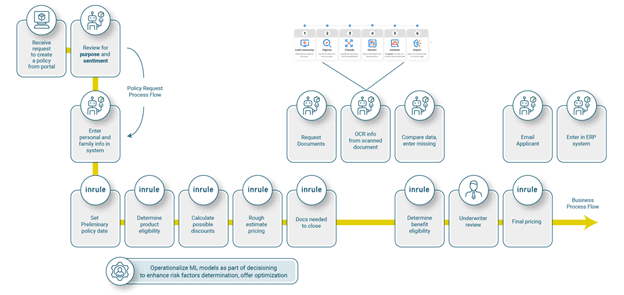
Today’s tech world is dominated by conversations about automation, artificial intelligence, and machine learning.
Working at InRule brings me to an exciting intersection of these technologies. However, when speaking with non-InRulians about our core competencies, I often find myself explaining the automation piece.
InRule’s core mission is to Make Automation Accessible for both technical and non-technical users. When I discuss InRule’s AI-powered end-to-end automation platform, I talk about our ability to automate decisions and processes and provide explainable and actionable predictions and decisions. People often ask me about the differences between automating digital decisions and processes, and often conflate the two with Robotic Process Automation (RPA).
Having had to explain multiple times that all three technologies are complementary but definitely different, I realized this might be a bigger conversation than I thought. Therefore, I thought it would be helpful to clearly state the difference between RPA, Digital Process Automation (DPA), and Decision Automation (DA) and how they work together.
Let’s dive in.
Robotic Process Automation (RPA)
Forrester Research defines RPA as a collection of software tools and processes that mimic and integrate human actions with digital systems, connect and manage diverse automation, and support governance and operating models to scale automation.
With basic RPA, a software robot literally performs tasks that a human would do. This includes routine tasks such as data retrieval and entry, button clicks, file uploads and downloads, and document processing. The application of RPA sits closer to the data sources; therefore RPA performs best mainly at the edge of a process.
I like to think of RPA as being similar to a macro in Excel. I can build out a sequence of steps in Excel, record them and make them into a macro, saving me time and effort in the future. RPA is a bit more advanced than macros, but it’s an easy way to begin to think about RPA properly.
RPA is currently one of the hottest technologies on the market today, and for good reason. RPA allows organizations to be more efficient, making repetitive and mundane tasks done by people a thing of the past. As a result, RPA provides not only a better experience for employees but also for customers.
However, there are limits to what RPA can automate. Typically speaking, anything that requires more enhanced thinking or logic or automating an end-to-end business process pushes the limits of RPA. It can perform basic decisioning such as true or false, but it falls short with advanced decisioning and deep decision automation.
Forrester introduced us to the rule of five, which summarizes RPA’s ideal fit nicely, “if you are looking for a tool to automate processes that require fewer than five decisions, need fewer than 500 clicks, and span fewer than five IT systems, RPA is the right choice for you.”
Digital Process Automation (DPA)
Digital Process Automation, or Business Process Management (BPM) if you’re an industry veteran, is a methodology to manage processes and workflows in an organization. A business process is a series of steps performed by stakeholders to achieve a concrete goal.
DPA software allows users to design a process or workflow with limited coding, and most will even have drag-and-drop editors. These processes or workflows can be designed to handle various things, such as what happens with a customer’s loan application once it’s complete, or reviewing a healthcare claim once submitted to the insurance agency.
Although similar to RPA, DPA does not complete tasks, such as processing an invoice or retrieving data; it simply kicks the task over to the person or system in charge of doing that task. Additionally, DPA does not make complex decisions either. While it can handle simple decisioning, for example, to determine who to route something to, complex, deep decisioning is not its intended purpose. While many DPA companies will claim some level of decisioning capability, it is basic in nature and only to make a simple choice in a process, not deep decision automation.
Decision Automation
Decision automation is the act of automating digital decisions, which Forrester Research defines as business logic produced by business experts that establish a fact, identify a pattern, make a choice, trigger a process, determine policy compliance, route an event, and surface knowledge.
A decision platform is software that allows both technical and non-technical users to define and execute decisions in real-time and embed them within applications. In addition, a decision platform provides tools to author, manage and integrate decision logic, analytics, and machine learning and AI models. As a result, a decision platform allows users to make real-time and repeatable operational and customer engagement decisions.
Decision platforms stand out due to their ability to handle complex conditional logic with numerous inputs at a vast scale; in fact, users typically run rule applications in batches with millions of decisions at a time. The InRule Decision Platform, offers a unique capability by proving Explainable AI capabilities as well, allowing for insight into decisions and predictions so that users can better understand and act on them.
Unlike RPA, decisioning is in the center of an application or workflow, rather than the edge. While decision platforms are great at evaluating inputs, applying business logic, delivering decisions, and providing insights into decisions and acting upon predictions, decision platforms do have limitations. For example, decision platforms typically do not automate tasks like data retrieval or document processing. Additionally, building processes and simple routing of tasks and actions are not a decision platform’s forte.
Putting it All Together
Now that we’ve taken a look at what RPA, DPA, and DA can do, let’s look at how these automations might work together.
Sometimes, when thinking about these various automation technologies, it makes sense to use a manufacturing analogy. So, let’s say we operate a condiment factory; we might make condiments such as ketchup, mustard, mayonnaise, and ranch dressing, for example.

In this example, the robotic arms and machinery that picks up the bottle, fills it, seals it, and slaps a label on it is the equivalent of RPA. Each separate task is highly repeatable and able to be automated, saving the workers time and effort, improving filling accuracy, label placement quality, and in most cases reducing risk.
When we think of DPA, we can think of the conveyor belt that moves each bottle from station to station. An operations engineer designed this process to automate and complete the bottle filling process in the same way a business analyst designs a workflow process to move a mortgage application from sales rep to the underwriter to approval. Without the process, the pieces can’t get between locations or team members automatically.
When we think of a decision platform and how it automates decisions, we can think of it as the brains behind the operations, informing the robotics and machinery and conveyor belts of what’s going on operationally. For instance, as demand decreases for ketchup and increases for ranch, the decision platform can alert the systems automatically to modify their actions to meet these new requirements. In addition, machine learning can enhance overall efficiency by examining trends and anticipating demand fluctuation to keep the operation running smoothly with minimal disruption.
This, of course, is a diluted example, but it does an excellent job of getting us to start thinking about how RPA, DPA, and DA work together.
A More Detailed Example
If we want to consider a more complex example, we can look at an insurance rating, underwriting, and quoting application. The application may use all three technologies, and the overall solution workflow might look something like the example below.

The process starts with a customer requesting a quote in an online portal; the process follows the green line, representing the workflow built out by DPA/BPM technology.
The RPA technology, which in this example is represented by a robot icon, recognizes the request and enter the user’s personal and family information into the system application. From here, the decision platform, which the InRule logo represents, performs several actions that have been previously defined by the organization’s subject matter expert. The first few actions include setting the policy date, determining product eligibility, calculating discounts, estimating pricing, and producing closing documents.
Throughout those same steps, the ML models that are part of the decision platform run in the background, enhancing the process by such as determining risk or providing optimal offers personalized to each customer.
After these steps, the DPA workflow kicks the process back to RPA, where the underwriter can request documentation, scan the document, compare the documents, and enter missing information. The process is then kicked back to the decision platform, where the overall benefit eligibility decision is determined. From there, the underwriter can accept or decline the decision. If the decision is accepted, the decision platform produces final pricing, RPA notifies the customer via email, and all relevant information is entered into the ERP system.
The great thing about this example is its scalability; once built, the process can be executed time and time again, completely transforming the organization, making them faster and more agile.
Hopefully, this provides a more detailed, real-world example of how the three technologies might work together and how the application architecture can be constructed.
Wrapping Up
I hope I detailed each of these powerful technologies and summarized the applications in which they add the most value. Now, when you chat with your friends, you can explain the differences and how they complement each other and create a powerful combined application that can transform organizations.
Should you have any questions, feel free to drop me a line below. Otherwise, I’d encourage you to check out our latest white paper Smarter Decisions, Smarter Predictions, which details how both decisions and machine learning work together and complement each other. Thanks for reading!


